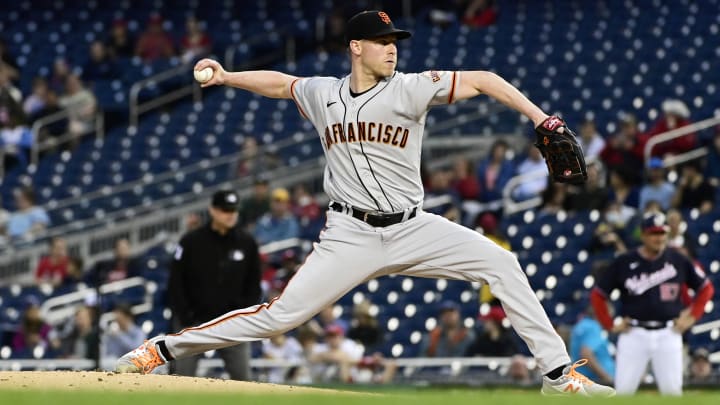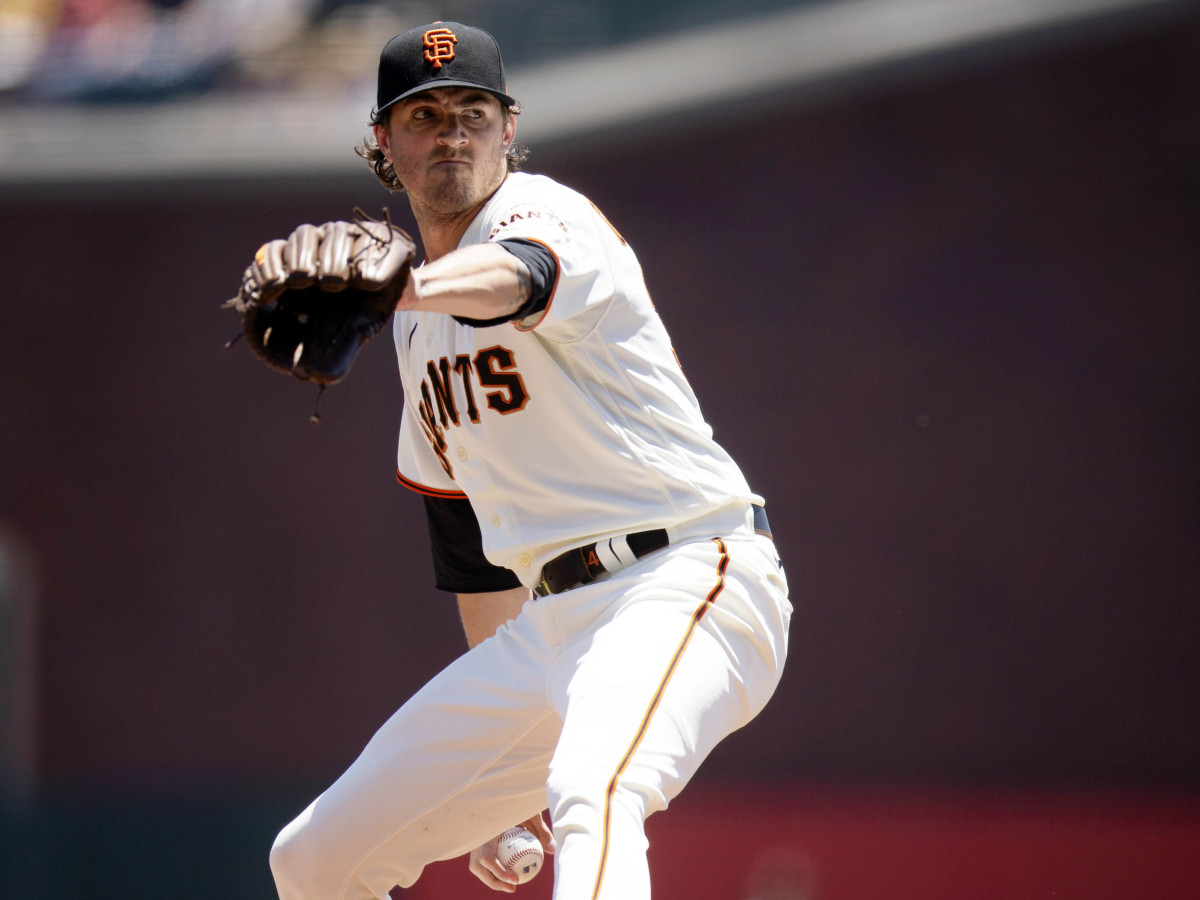Odd-Year Magic? Why the Giants Are for Real

Welcome to The Opener, where every weekday morning you’ll get a fresh, topical column to start your day from one of SI.com’s MLB writers.
If you need one pitch to explain the riddle why the Giants have the best record in baseball (46–26), it was the 1-and-2 slider Anthony DeSclafani threw Juan Soto in the fourth inning June 11 in Washington. Not only did Giants catcher Buster Posey call for the slider, but he also wanted it up and in—rising out of his crouch to set a rare high target for a breaking pitch.
DeSclafani has been pitching in the big leagues for seven years. Never did he strike out a left-handed batter on such a high slider. He had tried the same pitch at 1-and-2 against Soto in the first inning, only to miss badly outside. This time he executed the unusual pitch perfectly—3.3 feet off the ground and just off the inside corner. Soto reacted as you might expect from someone seeing a unicorn. Fooled, he swung underneath the pitch and whiffed.

“Exactly a pitch that he’s visualized in his mind,” San Francisco manager Gabe Kapler said, “and was able to make that come to fruition.”
Every day the Giants are up to such pitching tricks. Very quietly, and without the elite strikeout pitchers we have come to equate with premier staffs, San Francisco is game-planning and pitch-shaping its way toward the postseason.
The Giants could play .500 ball in their remaining 90 games and still finish with 91 wins. They have a 96.9% chance of reaching the postseason, according to Baseball Reference. And their pitching has been so thoroughly efficient that their method of winning looks sustainable.
The Giants have become the Rays of the National League. Young, analytically savvy run prevention specialists are taking well-traveled pitchers and making them better than ever by tweaking pitch mixes and game-planning—more so than via mechanical changes.
“I think it’s simpler than that,” Kapler said. “It’s about controlling count leverage and first-pitch strikes—things that have always played well. It’s also about knowing the hitters and knowing where you need to go to stay away from damage. And it’s about knowing your own players well. What do they do well that gives them the best chance to get outs? I’m not sure it’s all that complicated.”
Take a look at what the Giants do well: They throw strikes and ground balls—but this is not a high strikeout staff:
Giants Pitchers | MLB Rank | |
|---|---|---|
Groundball Rate | 47.6% | 1 |
Walks Per 9 IP | 2.63 | 1 |
First Pitch Strikes | 63.1% | 2 |
Pitches Ahead in Count | 30.8% | 2 |
BABIP | .266 | 2 |
Strike Percentage | 65.5% | 4 |
Strikeouts Per 9 IP | 8.62 | 21 |
What’s in their secret sauce? Game-planning. You must start with November of 2018, when the Giants hired Farhan Zaidi as president of baseball operations. Twelve months later, Zaidi hired Scott Harris as general manager and Kapler as manager. To less public notice, that month he also hired Brian Bannister as director of pitching.
Bannister had spent six years working his game-planning wizardry with the Red Sox. An art major at USC and former big league pitcher, Bannister is the founder of both a sabermetric research firm and a commercial photography studio. His listed areas of expertise in his LinkedIn profile are a window into how sophisticated pitching has become “predictive analytics, machine learning, pitch design, 3D motion capture, ball physics, biomechanical modeling and visual/cognitive deception.”
One month after hiring Bannister, the Giants hired Andrew Bailey as pitching coach. Bailey had only two years of coaching experience after retiring as a player, though in 2014, while rehabbing a shoulder injury, Bailey worked with young pitchers at the Yankees’ minor league complex, acquiring the foundation of pitching development.
After last season, the Giants hired J.P. Martinez as Bailey’s assistant pitching coach. Martinez had been pitching coordinator for the Twins.
Bannister, 40; Bailey, 37; and Martinez, 39; are the ones cooking up the secret sauce behind the Giants' pitching success. All of them have a background in player development, which has become an important part of major league coaching. They have developed a pitching culture that resembles an elite college physics lab: The thirst for information and shared knowledge drives innovation.
“It’s just feeling comfortable with this organization,” DeSclafani said in explaining why he is having a career year. “Love being here, love the team we’ve got. I feel like every guy has my back and the pitching [coaches are] always on everything, and trying to get every guy better. So it’s a lot of fun to work with them and be in this environment. It’s a good environment to succeed in and hopefully I can continue to do that.”
The Giants have had success with relievers such as Dominic Leone, 29, who has added velocity and still hasn’t given up a hit on his secondary pitches; Zack Littell, 25, who was DFA’d by the Twins, signed because Martinez liked him in Minnesota, and is throwing a splitter Bannister suggested; James Sherfy, 29, who was signed to a minor league contract in February; and José Álvarez, 32, a lefty who was signed in March and who this year has not thrown a pitch faster than 93 mph.
But the secret sauce of San Francisco is most apparent in the starting pitching. Take a look at what Bannister, Bailey and Martinez have done with their starters—most of whom had considerable track records.

Johnny Cueto: He has the lowest walk rate (4%) of his 14-year career. Cueto has not altered much of his pitch mix. His ability to deaden the baseball remains elite. Only Chris Flexen spins a changeup at a lower rate.
DeSclafani: A success story based on pitch mix. For the first time in his career, DeSclafani is throwing fastballs less than half the time (46%). He has boosted his changeups, sliders and curves. The result: more ground balls than ever (47%). The batting average on balls in play against him has dropped from .318 to .243, a career low.
Kevin Gausman: He is playing up his best pitch, the splitter. Since joining the Giants last year, Gausman has thrown his fastball less often than ever before (51% and 50%) while throwing his splitter more.
Gausman once relied on his four-seam fastball as much as 68% of the time. The pitch, while thrown hard at 94–95 mph, does not have great characteristics. Batters hit .323 against it in 2019. But the Giants not only have Gausman throwing it less often, but they also have him throwing it higher in the zone. Coupled with his nasty split, Gausman is dominating with a classic high-low game.
Sammy Long: The 25-year-old has been an amazing success story after being out of baseball two of the previous three years. Cut from the Rays' system in 2018, he briefly quit baseball to take EMT classes toward becoming a firefighter. He decided to give baseball one more shot. He changed his diet, started training and returned to the conventional delivery he used before the Rays switched him to sidearm. After he posted a video online, the White Sox signed him to a minor league deal in '19.
The pandemic wiped out another season for him in 2020, after which the Giants signed him to a minor league deal. Long throws his curveball 40% of the time—and nobody has a hit against it yet.
Aaron Sanchez: As a Giant, he is throwing fewer fastballs than ever (43%). Sanchez has bumped his usage of curves and changeups. The result: Sanchez is allowing the lowest exit velocity of his career (86.5 mph).
Logan Webb: Like Gausman, Webb is playing up his best pitch. The young righthander has doubled his sinker use, from 15% to 30%.
Webb’s sinker has elite movement. He is throwing 58% ground balls while allowing only four home runs in 10 games.
Alex Wood: He is a better ground ball pitcher than ever before in his nine-year career (55% ground ball rate).
Injuries limited him to 19 ⅓ innings last season, including the postseason. In that time Wood replaced his curveball with the sharper-breaking slider, a transition he has refined this year. Wood threw his curve as a pitch that dropped into the zone, whereas the slider is more of a chase pitch that follows a strike-to-ball path. Batters are hitting .155 against Wood’s slider.
DeSclafani, Gausman, Sanchez and Wood all were signed to one-year contracts.
Pitching doesn’t work in a vacuum. For a strike-throwing team that puts the ball as much on the ground as the Giants, the formula works with only a premier defense behind the pitchers. The Giants have it. Only the Astros are better at turning batted balls into outs.
Moreover, in the second year under Kapler, San Francisco has been more judicious—and smarter—about shifts. It has cut its shift usage from 33% last year to 22% this year. The result: It has dropped the BABIP on line drives and grounders against the shift from .339 to .306. Only San Diego defends line drives and grounders better when in a shift. That’s more smart baseball.
Add it up—the young, savvy run prevention specialists, the ground-ball-throwing rotation and the elite defense—and you begin to understand why the Giants are winning. It is with an old formula, pitching and defense, with a modern twist.
More MLB Coverage:
• 'A Game of Speech'—But Also, for Baseball Interpreters, so Much More
• Tragedy and Hope: A Prospect, a Scout and a Pop Fly
• He Made Sticky Stuff for MLB Pitchers for 15 Years. Now He's Speaking Out.
• Brandon Crawford Is Back—And So Are the Giants
